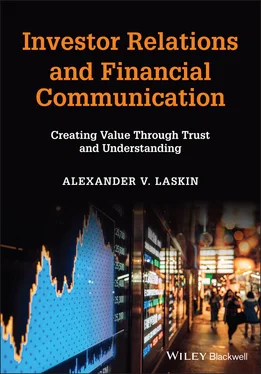When the definition talks about fair value, it talks about the fair value of the company’s securities . So, what are securities? In the simplest terms, securities are tradable financial instruments. There are generally two types of securities: equity and debt. Equity securities represent an ownership in a corporation stock. These are usually called shares of stock. People can buy shares in many publicly traded companies – for example, Microsoft, Tesla, or Snap – each share has a price that fluctuates based on all the information available about the company and the resultant supply and demand for the shares of this company. If somebody were to buy every single share of, for example, Tesla, they would own the whole company. Owning shares of companies makes you a shareholder – you become eligible to participate in shareholder meetings and vote on various issues around how the company is run, including the election of the Board of Directors. The more shares you have, the more votes you have. Not all shares are the same and not all give the same rights and privileges; in addition, corporations may introduce their own unique type of equity securities as well.
Debt securities do not represent ownership in a company – instead, it is just a debt, a loan that must be repaid. As a result, debt holders do not get to vote on issues related to how a company is run, but they get their money back as the loans are paid back by the borrower and usually with interest. Both of these types of securities, equity and debt, may be traded; for example, if a debt holder does not want to wait till the loan is due for repayment, they may sell their debt securities on the secondary market to somebody else.
The same is true for equity. However, shares do not have any repayment or expiration date – once you buy a share of a company, you have a share in the ownership of this company forever. If you decide at some point that you would rather part with your shares, you can sell them on the secondary market to somebody else. Although the corporation that originally issued those securities does not typically participate in these transactions on the secondary market, it has a big effect on the price of its securities. Consider somebody who bought a share of Apple stock in 1990 when the shares were traded on a secondary market for about 30 cents. Today, the same share is worth about US$120. Investing a few thousand dollars in Apple stock 30 years ago would have made a significant contribution to the investor’s retirement account balance today. This increase in value is also good for a corporation: if a company decided to raise additional funds and sell more securities, it would be evaluated based on its current price not based on the 30-cent value from 30 years ago – it makes it easier for corporations to finance big projects.
NIRI’s definition of investor relations also talks about the way the fair value is built – specifically, it talks about two-way communication . What makes communication “two-way”? When the company sends out a news release or posts information on its website, it communicates in a one-way fashion – from the company to the outside world. There is nothing wrong with one-way communication – it is an appropriate communication technique in many situations, but it has its drawbacks, and it does not work all the time. For example, the company may be disclosing torrents of information about cost-cutting measures and new business development ideas, but without feedback from shareholders the company cannot know if shareholders actually understand how these new business ideas affect the company’s business model. This feedback becomes the return loop in the communication process and the communication becomes two-way communication.
In other words, in two-way communications both parties have a chance to speak and to be heard, and the information travels both ways – from the company to the stakeholders and from the stakeholders to the company. This puts an extra responsibility on the IROs – they are responsible not just for disclosure, or sending the messages out, but also for listening. IROs must be not only the mouthpieces of their organizations, but also their ears and eyes. Two-way communication is an essential part of investor relations if the goal of investor relations is educating investors and others in the financial community on the value of the company – education calls for two-way communication and dialogue. Investors must have the opportunity to ask questions and ask for clarifications in order to improve their understanding; in fact, IROs should welcome these investor inquiries as they help IROs understand where investors stand and what their expectations of the company are.
But there is more to two-way communication than enhanced understanding. Ultimately, investors are the owners of the corporation and the company’s management has a fiduciary duty to them, a duty to act in the best interest of the investors. Part of this process is for IROs to listen to investors and then to communicate the messages from the investors to the company’s management. Indeed, if the company’s management works for the shareholders, the management should know what shareholders think of their performance. It is the responsibility of IROs to collect this information and communicate it to the company’s management. As a result, investor relations departments must focus on building two-way communication channels to enable dialogue between corporations and a financial community.
The definition of investor relations talks about various skills that IROs must possess in order to do their jobs successfully: finance, communication, marketing, and securities law compliance. In fact, it may sound like four different professionals should be doing this job! Indeed, as an IRO you have to be knowledgeable in all these four areas – you need to be an expert communicator, after all, two-way communication is a foundation of the profession as we have just learned. But the topic of the communication often revolves around financial content – IROs’ communications are often financial communications – meaning communications about sales, profits, expenses, earnings before interest, taxes, depreciation, and amortization (EBIDTA), earnings per share (EPS), rate of return, and other financial terms. It may be challenging even for the best communicators to talk about subjects they know nothing about. So, understanding of accounting and financial concepts in investor relations is important. In addition, all these communications are occurring in a highly regulated environment – there are many rules on what information must be communicated, when it must be communicated, and what channels must be used to communicate it. There are rules against selective disclosure and against trading on privileged information. All these rules require IROs to be knowledgeable about laws and regulations governing the securities markets and make IROs agents of enforcement of these regulations. Investor relations is also part marketing. Investor relations professionals are expected to engage in and build relationships with the financial community – identify investors who may be a proper target for the company’s stock, increase the coverage of the company by the financial analysts, and even promote stock to retail shareholders.
As a result, it is quite common for IROs to have multiple educational degrees. A study that analyzed educational backgrounds of IROs at Fortune-500 companies found that almost 60% of IROs had a second, graduate-level degree. It is not uncommon that if an IRO’s first degree is communication-based, they would earn a second degree in finance or accounting to complement their communications expertise; in some cases, maybe even a law degree. If an IRO has an undergraduate finance or accounting degree, however, then they may complement it with graduate studies in communication or marketing. In addition, NIRI has a variety of professional development opportunities available for its members to enhance their knowledge and skills.
Читать дальше











